Recently, China River Cruise Tours are booming. Yangtze River is the longest river in China and a great number of people would like to enjoy its wonderful scenery. If you are interested in the Yangtze River, China Tour including Yangtze River Cruise will surely meet all your expectations. In addition, Chongqing to Yichang River Cruise will lead you to visit the Three Gorges, which are the most beautiful gorges of the Yangtze River. Besides the Yangtze River, you will go to Beijing to see the charm of China’s capital and experience the essence of history in Xi’an. Furthermore, Zhangjiajie National Forest Park will show you the mysterious scenery of the forest, while Shanghai brings you a modern city. Are you ready to be in the transition of tradition and modernity? So, let’s go now!

Thank you for choosing our service, and we will give you a top Yangtze cruise tour. Your first stop is Beijing. Your guide will meet you at the airport and take you to the hotel in the downtown. After that, you are free to plan your own activities.
Are you getting energized and ready for today’s attractions? If so, let’s go! First, you will visit Tian’anmen Square. Beijing, a thousand-year-old city, has many famous and symbolic buildings, among which Tian’anmen Square is the most attractive one. Located in the center of Beijing, Tian’anmen Square is the largest city square in the world as well as the political and cultural center of Beijing. It is 880 meters long from north to south and 500 meters wide from east to west, covering an area of 440,000 square meters. On October 1, 1949, the founding ceremony of the People’s Republic of China was held in Tian’anmen Square, which has therefore become the symbol of China and a holy place in the minds of the Chinese people. Also, it is China’s most important venue for major national celebrations. For example, the 70th anniversary of the founding of the People’s Republic of China and the 100th anniversary of the founding of the Communist Party of China were held there. You can only appreciate its grandeur if you come here.
After that, you will see the Forbidden City (closed on Mondays). It is the royal palace of China’s Ming (1368-1644) and Qing (1639-1912) Dynasties and 24 emperors once lived here. As the largest existing royal building in the world, the Forbidden City was built in 1406 and completed in 1420. It can be roughly grouped into two parts: the Outer Court in the south (the place where the emperor conducted state affairs) and the Inner Court in the north (the place in which the emperor and his concubines lived). All its buildings were arranged around a central axis, symmetrical and orderly. The outer Court consisted of three main halls: the Hall of Supreme Harmony, the Hall of Central Harmony, and the Hall of Preserving Harmony, among which the Hall of Supreme Harmony was the most magnificent one. The inner court includes the Palace of Heavenly Purity, the Palace of Earthly Tranquility, Hall of Union, Six Eastern Palaces, and Six East Palace. There are more than 70 palaces and 9,000 rooms in total in the Forbidden City. In the north of the Inner Court stands a beautiful garden for the royalty to enjoy. Here, we must talk about the city’s builder——the Emperor Yongle, Zhu Di. In fact, the capital of the Ming Dynasty was originally in Nanjing, but Zhu Di moved the capital to Beijing after he ascended the throne. So, what’s the story behind this? In 1398, Zhu Yunwen, Zhu Di’s nephew, succeeded to the throne and later killed five of his uncles. Zhu Di thought that if he did not do something, he would sooner or later be killed by his nephew. Being supported by many people and having great forces, he decided to revolt and overthrow his nephew’s rule. In 1402, he succeeded in defeating his nephew and becoming the emperor. But during his first years as emperor, he had a difficult time. In Nanjing, a lot of ZhuYunwen’s former subordinates wanted to turn against his rule and even kill him. In order to consolidate his rule, Zhu Di decided to move the capital to Beijing, where used to be his fief. He had been lived there for many years and had more supporters. Moreover, Beijing enjoys the superb geographic location, with Juyongguan Pass in the north, Tai-hang Mountains in the west, Shanhaiguan Pass in the east, and the Central Plains in the south. All these would help him rule the country. When he told his ministers this idea, they agreed with him. So, Zhu Di ordered some ministers to recruit workers to build a new palace in Beijing, that is, the Forbidden City. It is said that the gathering of wood for the new palace lasted thirteen years! What a huge project!
In Beijing, there is such a place, which has no noisy traffic and high-rise buildings, and only has the simple people and the strong flavor of old Beijing people’s life. That is where we are going today, namely, Hutongs, ancient urban alleyways in Beijing. More than 7,000 hutongs are scattered throughout the city. The names of Hutong are various. Some are named after characters, such as Wen Prime Minister Hutong, some are after animals, such as Goldfish Hutong, and some are after flowers, such as Prunus Hutong and so on. Do you find that interesting? Come and have a visit here!
Have you only seen rickshaws on TV? Today, you will have a rickshaw tour to look around in Hutongs. When you visit Hutong in a rickshaw, you will feel like going back to the old life in Beijing and appreciate the simplicity of old Beijing.
Then you will go on a Hutong Family visit with your guide. At this time, you can enter an authentic quadrangle courtyard in Beijing, where the residents will warmly welcome you, invite you to drink tea, and tell you a lot of interesting stories that happened in the Hutong.
Next, your tour guide will take you to visit 798 Art Zone. You may be wondering why this place is named after three numbers. In fact, the art zone used to be an abandoned state-owned factory called factory 798. In order not to reveal the secrets of their production, the state named the factories after numbers. From the 1980s to the 1990s, the factory 798 gradually declined, and finally the factory ceased production and the site was opened to the public for rent. Later, because of its low rent, many artists from Beijing and the surrounding areas came here to open their studios, and gradually it became an art zone. Nowadays, the 798 Art Zone is Beijing’s art center, displaying a wide range of paintings, graffiti, photographs, and sculptures. A visit there is going to be a feast for your eyes. Since 2004, the Prime Minister of Sweden, the Prime Minister of Switzerland, the Chancellor of Germany, the Chancellor of Austria, and the president of the European Union have all visited the 798 art Zone. Do you want to know why so many celebrities are attracted to this place? Come here to find the answer!
Then you will be transferred to the hotel to have a rest.


Ming Tombs in Beijing are the resting places of 13 Ming emperors after their deaths. Today, we will drive northwest for an hour (54KM) to Chang Tomb which is the most magnificent tomb of Ming Tombs. Built in the 7th year of the reign of Ming Emperor Yongle (1409), Chang Tomb covers an area of about 120,000 square meters, and it is the joint tomb of Ming Emperor Zhu Di and his Empress Xu. Zhu Di was one of the greatest emperors in the Ming Dynasty. Politically, he weakened the power of the vassal states to strengthen the imperial power. He also moved the capital to Beijing and gradually changed it into a famous and prosperous international metropolis, laying the foundation for the development of modern Beijing. Moreover, he ordered to build the Forbidden City, the Temple of Heaven, and the Imperial Ancestral Temple in Beijing. Diplomatically, he sent Zheng He (a minister of the Ming Dynasty) to voyage to the Western Ocean seven times, developing friendly international relations with countries along the way. Come here to learn more about Zhu Di!
Let’s have a break for lunch.
After lunch, we will drive northeast for an hour (40KM) to Mutianyu Great Wall. With a length of 5,400 meters, the Mutianyu Great Wall is the longest section of the Great Wall in China. With the dramatic mountains and lush forests, it has an impressive scenery. It winds like a giant serpent along the lofty myriad mountains. In addition, it has well-equipped tourist facilities, which can meet the different needs of tourists to climb the Great Wall. For the elderly, a cable car is the best option. If you’re agile, why not try a chairlift? Another way is to take a toboggan downhill, which will make you feel great fun. Join us to enjoy the spectacle of the Mutianyu Great Wall.

 Xi’an
Xi’an After breakfast, you will go to the train station to take the estimated train G571 09:22/15:06 to Xi’an. After arriving in Xi’an, your local guide will send you to a hotel to have a good rest.
Located in the center of China, Xi’an has a population of 12,952,907 and an area of 10,108 square kilometers. As the capital of more than ten Chinese dynasties in history, it has an abundance of historical and cultural heritage. During your visit, you are sure to feel the charm of this city.
This morning, we will drive northeast for about 40 minutes to get to Terracotta Warriors and Horses Museum. The Terra Cotta Warriors and Horses Museum is part of the Mausoleum of the First Qin Emperor and all warriors and horses inside are made from baked pottery. So far, three pits have been excavated, covering a total area of nearly 20,000 square meters, and including almost 8,000 terra cotta warriors and horses. Pit No. 1 owns the largest area of 14,260 square meters and the highest number of 6,000 terra cotta warriors and horses. As mentioned above, all the terra cotta warriors and horses were built for the First Qin Emperor. So, what kind of man was he? In 221 BC, he unified six States (states of Qi, Chu, Yan, Zhao, Wei, and Han), making China a uniform nation. Then, he unified the tools of weight and measure and stipulated seal characters as standard language. In brief, he was a great emperor.
After lunch, you will go to Big Wild Goose Pagoda. Located in the Ci’en Temple in the southern suburb of Xian, it was built by Master Xuanzang of the Tang Dynasty (618-907) as a tower for storing scriptures. Since the pagoda was built, more than 70 earthquakes and excessive groundwater exploitation have caused the pagoda to lean about one meter to the northwest. But now the government and the Heritage Conservation Bureau are strengthening the foundation, recharging groundwater, and sealing up the surrounding underground wells to rectify the Pagoda. It is said that it will take 1,000 years for the Pagoda to be restored to its original position!
Your next stop is the Xi’an City Wall, which was built in the early Ming Dynasty and is the most complete ancient wall in China. About 26 million bricks were used to build the wall, and the total length of these bricks is equivalent to about five roundtrips from Xi’an to Shanghai. By the way, riding a bike on the city wall is an amazing experience!


 Chongqing
Chongqing After breakfast, you will take the estimated train D1971 09:05/13:42 to Chongqing. Known as a mountain city, Chongqing is built leaning the mountains and is the starting point of your Yangtze River Cruise Tour.
We will provide you a lunch box before you get on the train. It contains a sandwich, a soft drink, some snacks and fruits.
After arriving in Chongqing, a local guide will meet you at the airport and take you to visit Ciqikou Ancient Town. As a busy pier in the past, this town was famous for the production and transshipment of porcelain. Now, it is a good place to experience the customs of Chongqing.
Then your tour guide will lead you to the Chaotianmen Pier to take the Yangtze River Cruise Ship. After helping you go through the formalities, the guide will get off the cruise ship. The cruise ship stops boarding at 20:30 and leaves at 21:00.


Today, you will have a Shore excursion to Shibaozhai Pagoda, which is also called “the Pearl on the river”. Standing on the pagoda, you can enjoy the beautiful view of the Yangtze River. The pagoda was built leaning a huge stone riverside. There is a story behind this stone. Once upon a time, the sky suddenly broke, and a huge hole appeared. Nüwa, a fairy, mended the sky with some very large stones. It is said that this stone was left by the Nüwa after she mended the sky. People considered this stone as a treasure left by the fairy so called it “Shibao” (stone treasure). Moreover, Shibaozhai Pagoda once was a stockaded village. In Chinese, zhai means stockade village. So, it gets its name “Shibaozhai Pagoda” (camping area). Then you will go to visit Fengdu “Ghost City” (extra charge), which is well-known for its various underworld-style buildings and sculptures.
In the evening, a captain’s welcome reception will be held on the cruise ship.
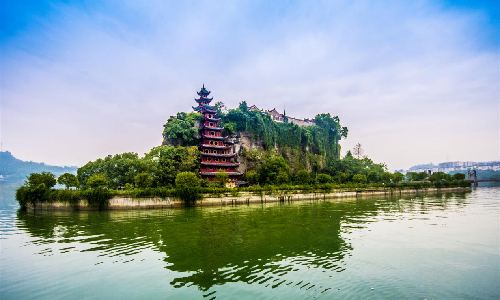

After breakfast buffet, you can play Tai Chi on the deck. Today you will visit the Three Gorges, which include Qutang Gorge, Wu Gorge, and Xiling Gorge from west to east.
Qutang Gorge is only 8 kilometers long, but it is the most precipitous part of the Three Gorges. The maximum flow rate of the river reaches 8 meters per second, even more than 20 kilometers per hour. Both sides of the gorge are sheer cliffs and steep mountains. It is very thrilling to sail in such a gorge. The entrance of Qutang Gorge is called “Kui Gate”. “Kui Gate” gets its name because it is located in Fengjie County, which was called Kui State in ancient times. On its sides, the mountains tower into the sky, and the river roared on, swift and violent, which will make you breathtaking. Moreover, the scenery of “Kui Gate” is represented at the back of the fifth edition of the 10 yuan banknote.
At noon, you can enjoy a lunch buffet.
With a total length of 40km, Wu Gorge is flanked by oddly shaped rocks and steep peaks. It is also famous for its Twelve Peaks of Wushan Mountain, among which Scissor Peak has drawn many people’s attention. Scissors Peak is a mountain whose top is divided into two parts and looks like a pair of scissors. But looking from the side, it looks like a pillar. You can see different shapes of the peak in different directions. Besides, you will change a boat to visit Goddess Stream, a little-explored pristine gorge.
The final one is Xiling Gorge. It has a total length of 66 kilometers and is the longest part of the Three Gorges. Dengying Gorge is one of the most unique gorges among all the gorges in Xiling Gorge. Although it is not long, the gorge is narrow and straight, with cliffs on both sides, strange peaks on the top, and stone pillars rising from the ground and into the air, making it an extraordinary sight. During the daytime, the cliffs are reflected in the river, and the blue sky and white clouds make the scenery look like an atmospheric ink painting.
This evening, a Captain’s farewell dinner will be held on the cruise ship and you can enjoy some fascinating shows.
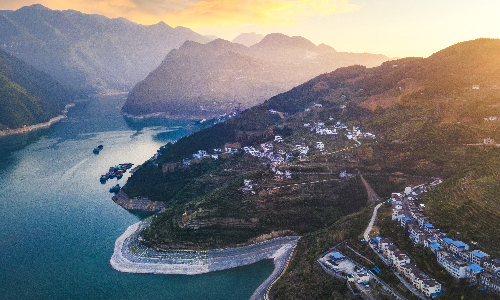

 Zhangjiajie
Zhangjiajie After waking up in the morning, you can go to the dining room for a breakfast buffet. Today you will see the Three Gorges Dam Site. With a total length of 2,308 meters and a height of 185 meters, the dam is the world’s largest hydropower project. It has brought significant benefits to flood control, power generation, and navigation. When you come here, you will have a panoramic view of the dam and the wonderful scenery of the Yangtze River.
Then, you’ll take a bus to get to Yichang Three Gorges Center Cruise Terminal and meet your guide. Then you will be transferred to the train station and take the estimated train K1473 12:58/17:54 to Zhangjiajie. After arriving, the local guide will lead you to the hotel near Yuanjiajie.

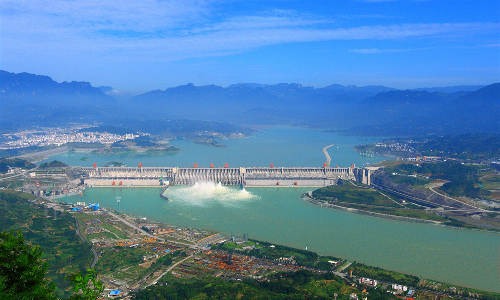
After breakfast, your tour guide will lead you to visit Zhangjiajie National Forest Park. Located in Zhangjiajie, this park was established in 1982 as China’s first national forest park. There, you’ll find a park that embraces a sense of magic, vigorous momentum, and primitive beauty. And the gate of the park is a spectacular natural combination of the garden-style buildings of the Minority Tujia and steep peaks. It is said that on May 28, 1992, UNESCO sent two officials to inspect and accept the application of Zhangjiajie National Forest Park as a World Natural Heritage Site. When they drove 100 meters past the gate of the park, they repeatedly shouted, “Gate, Gate!” and asked the driver to drive the car back to the front of the gate, where they praised the beauty of the gate and repeatedly clicked their cameras to record this spectacle. The establishment of national forests is not only for tourists to visit, but also to curb the destruction of forest resources and protect the ecological environment at the same time.
Then you will take a cable car to visit Huangshi Village, which brings together a variety of beautiful views and is the largest viewing observation deck in Zhangjiajie. It is more than 1,200 meters above sea level and covers an area of 160,000 square meters with sheer precipices and overhanging rocks on all sides. You can enjoy all kinds of extraordinary sights there, among which “Tianshubaoxia” (a rectangular stone like a treasure box) enjoys great popularity. In the village stands a circular stone column more than 20 meters high. At the top of the column is a platform, on which there are five pine trees surrounding a rectangular stone shaped like a box, which is about 3 meters long, 1.5 meters wide, and 80 centimeters thick. seeing this scene, you must be amazed at the uncanny workmanship of nature.
Then you will take the cable car down the mountain to visit the Golden Whip Stream. With a total length of 6.5 kilometers, Golden Whip Stream passes through the park from west to east. The two sides of the stream are full of wonderful peaks and ancient big trees, making the scene unusually quiet. The place that the Golden Whip Stream passes through is regarded as “the most beautiful canyon in the world”. The Golden Whip Stream runs through the Golden Whip Rock, the most famous peak in Zhangjiajie National Forest Park, all year round. The Golden Whip Rock is 378 meters high, in the shape of a steel hammer, with the lower half larger than the upper half. It is composed of red quartz sandstone and limestone, which makes it glow in the sunlight, hence the name "Golden Whip". Moreover, it is the highest, steepest, and most spectacular peak in Zhangjiajie. There is a beautiful fairy tale about the origin of the Golden Whip Rock. Legend has it that the first emperor of Qin got a magical whip that could move mountains. In order to expand the territory, he planned to use the whip to move several mountains to fill the East China Sea. The Dragon King of the Eastern Sea did not want the sea to be filled, so he sent his daughter to pretend to marry the First Emperor. On the wedding night, the Dragon King’s daughter got the emperor drunk and exchanged her fake whip for the real whip. The next day, the emperor found that the whip had been replaced, and he was so angry that he threw the fake whip on the ground. With a loud bang, the whip immediately turned into a towering peak, which is today’s Golden Whip Rock. Later there is a popular saying that the dragon King dominates the sea and the golden whip can move the mountains.
Your next stop is Zhangjiajie Grand Canyon. The canyon is cool and comfortable with lush vegetation and fresh air. Come here just like going into a Xanadu and you will surely forget your troubles. When visiting other sightseeing spots in Zhangjiajie, people can only see or overlook the steep mountains and different streams from a distance, and only here can they experience a sense of close contact with nature.
Then you can go to Zhangjiajie Glass Bridge for a walk. The bridge is 430 meters long and 6 meters wide, about 300 meters above the bottom of the canyon. Zhangjiajie Glass Bridge is the world’s largest and longest glass pedestrian bridge. Standing on the bridge and viewing the canyon hundreds of meters below your feet is a must-experience activity.
That’s the end of today’s tour. You will be transferred to the hotel to have a nice rest.
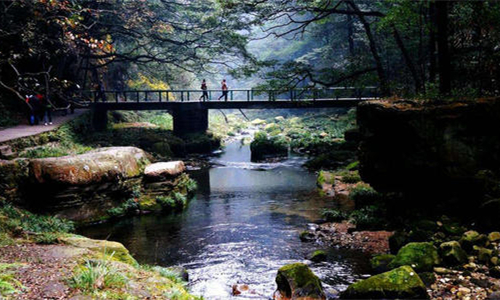

 Shanghai
Shanghai What’s the height of the tallest elevator you’ve ever take? Today, you will take the Bailong Elevator, which has been given a place in the Guinness Book of World Records as the highest outdoor elevator. With a vertical height difference of 335 meters and an operational height of 326 meters, it is a perfect combination of natural beauty and man-made wonder. In the past, tourists had to walk more than three hours to get to the top of the mountain, but since the completion of Bailong Elevator, the time to reach the top has been reduced to 92 seconds, which is a miracle. It has successfully solved the traffic bottleneck that has been plaguing the sightseeing area for many years.
After taking Bailong Elevator to the top of the hill, you will come to the core sightseeing spot of Zhangjiajie, that is, Yuanjiajie Scenic Area. Located in the north of Zhangjiajie National Forest Park, Yuanjiajie Scenic Area covers an area of about 12 square kilometers and has an average elevation of 1,074 meters above sea level. Standing on the viewing platform there, you will have a panoramic view of three thousand wonderful peaks with various shapes. One of the wonders of Yuanjiajie is Qiankun Pillar (a very high peak), the prototype of the floating Hallelujah Mountains in the American science fiction movie, namely “Avatar”. Located in the south of Yuanjiajie Scenic area, the peak has a vertical height of about 150 meters and the top of it is covered with lush vegetation. It towers into clouds and the shape of it is very peculiar, just like being chopped by knives and axes. After the film “Avatar” hit the world, hundreds of millions of visitors at home and abroad are attracted to Yuanjiajie Scenic Area to see the Hallelujah Mountain every year.
During your Yangtze River Cruise Tour in Zhangjiajie, you can only look up at the peaks. However, for your next stop, you will feel that the mountains are under your feet. So, your next stop is Tianzi Mountain. The tour guide will lead you to take the shuttle bus to this mountain, which is characterized by grotesque peaks surrounded by clouds. The Tianzi mountain covers a total area of 54 square kilometers, with the highest peak of 1,262.5 meters, and the lowest of 534 meters. Why is this mountain called Tianzi Mountain? It is said that in the late Song Dynasty (960-1279), the Tujia people (an ethnic minority of China) were oppressed and exploited by the imperial government. In order to lighten the burden of the people, Xiang Dakun, the leader of the Tujia people, decided to launch an uprising against the imperial government. He called himself “Xiang Wang Tian Zi” (Tian Zi means the emperor). Although the uprising failed in the end, the Tujia people considered him a national hero and named the mountain “Tianzi” to commemorate his achievements.
Then, you will take the cableway for 10 minutes to get to the Ten Mile Gallery. The gallery is a valley more than ten miles long, with lush trees, wildflowers, and grotesque peaks and stones on both sides, making it looks like a landscape scroll. When you come here, you will feel that you are in a painting, so it is called “gallery”.
Then, you will leave for Shanghai by taking the estimated flight FM9342 20:40/22:50. After arriving in Shanghai, your guide will meet you at the airport and take you to the hotel to have a good rest.
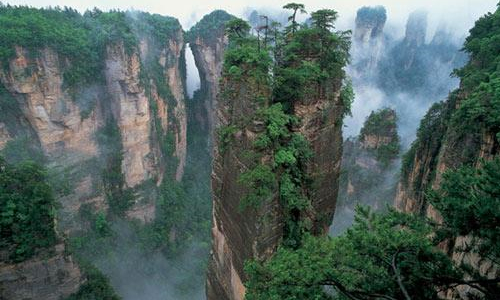

This morning, you will head for Yu Garden (closed on Mondays), which is located in Huangpu District of Shanghai. As a typical classical garden in the south of China, it was built in the Ming Dynasty and covered an area of more than 20,000 square meters. It is famous for its picturesque pavilions, oddly shaped rocks and beautiful ponds. The buildings in the garden are carefully designed and the layout is compact. However, the best-known part is its top treasure, that is, a Taihu rock called Jade Exquisite. This rock was transported from Taihu Lake in Jiangsu Province, so it is called Taihu rock. It is about 3 meters high, 1.5 meters wide, 80 centimeters thick, and weighs about 3 tons. The stone is covered with holes. The holes are connected to each other. If you burn an incense under the hole at the bottom of the stone, curls of smoke will be emitted from all the holes of the stone. If you pour a basin of water at the top of the stone, all the holes will gush out crystal water, which can be called wonderful. Actually, there is an interesting story about this stone. According to the legend, during the Ming Dynasty, Pan Yunliang, the younger brother of Pan Yunduan who was the owner of Yu Garden, married the daughter of a minister. To celebrate his daughter’s marriage, the minister decided to give Pan Family a treasured Taihu rock called Jade Exquisite. Unfortunately, when the boat carrying the rock crossed the Huangpu River, the boat and the stone sank due to a sudden gust of wind. Pan Yunduan thought this was a bad sign and must seek to patch things up. Therefore, he spent a lot of money looking for experienced swimmers to help bring the rock ashore. After the Jade Exquisite was brought back, the swimmer also picked up another rock at the same time. It was strange that the rock picked up can be perfectly put under the Jade Exquisite as a base. Isn’t it interesting? Since then, Jade Exquisite has become the top treasure of Yu Garden.
Your next stop is Shanghai Old Street. Known as Little East Gate, it is located in the Shanghai Old City Area of Huangpu District. It starts from Henan South Road in the west and ends at Renmin Road in the east, with a total length of 825 meters. As the gathering area of all walks of life, the Old Street once brought together a group of Shanghai’s earliest banks, gold shops, silver buildings, restaurants, teahouses, opera houses, and firms, which can best reflect what Shanghai used to look like. Walking into Shanghai Old Street, you will feel like going back to the bustling market of Shanghai 100 years ago. Here, you can see the residential buildings of the early Republic of China (1912-1949) and the Ming and Qing Dynasties. It must be a good place for you to experience the customs of old Shanghai.
At noon, we will take you to have lunch.
Next, you will come to Tianzifang Market, which is located at Lane 210, Taikang Road in Shanghai. Renovated from Shanghai’s unique Shikumen (residential building) architectural complex, Tianzifang Market is building itself into a creative industry cluster and a work base for many artists. It is a highland integrating creativity, history and fashion, as well as a platform through which artists’ personalities can be fully showed. Various kinds of shops, such as cafes, art shops, galleries, ceramic art stores, and home goods store can be seen everywhere, and the art abounds in the market. When you stroll in this market, all kinds of arts and crafts will certainly catch your eye and allow you to linger. If you love art, this place will surprise you. In this creative market, you can make your own lipstick according to your favorite color, taste, shape, and lipstick tube. Come and experience it!
After that, you’ll visit Shanghai Tower, the landmark of Shanghai. With East received Shanghai World Financial Center and north suffered Jin Mao Tower, Shanghai Tower is located in Finance and Trade Zone of Lujiazui, Pudong New Area, Shanghai. Covering a total construction area of 578,000 square meters, it consists of 127 floors above ground and 5 floors underground and has a total height of 632 meters. As a comprehensive skyscraper, the tower is divided into five functional areas, including the mass commercial entertainment area, office area, the Business Guildhall area, the hotel area, and the top functional experience area. Situated on the 118th floor of Shanghai Tower, the sightseeing called “Shanghai Zhi Dian” (the top of Shanghai) covers an area of more than 1,000 square meters and has a vertical height of 546 meters. You can enjoy a panoramic view of the city there. Moreover, Shanghai Tower is equipped with the world’s fastest elevator, which can reach a maximum speed of 18 meters per second. And it only takes you 55 seconds to reach the 118th floor. More importantly, the tower has strong ability of anti-wind and even can resist the front of the grade 16 typhoons attack. So why can Shanghai Tower resist strong wind? This is thanks to its wind damper inside. A wind damper is a huge iron ball that hangs inside Shanghai Tower and can stabilize the building by swaying when there is a strong wind. It is known that the wind damper inside the tower has a maximum pendulum deflection of 2 meters, but the super typhoon (grade 17) Limaqi (the name of the typhoon) only made the damper swing 50CM. Therefore, no matter how strong the wind, Shanghai Tower can be as steady as Mount Tai. (Mount Tai has been regarded as a symbol of national stability since ancient times).
Then, you will be transferred to your hotel for a rest.
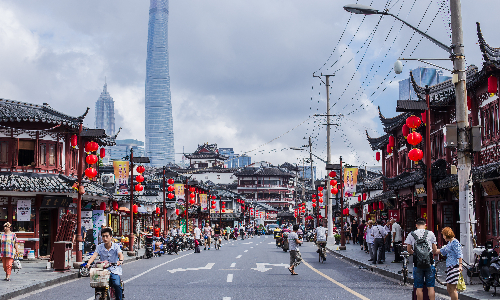

This is the end of your entire journey. After breakfast, your tour guide will send you to the airport. Good luck on your journey!
Author: Yan Ran
Proofreader: Lexie
| City | Five Star hotel list | Four Star hotel list |
|---|---|---|
| Beijing | Sunworld Dynasty Hotel Beijing Wangfujing | Sunworld Hotel Wangfujing |
| Xi'an | Tianyu Gloria Grand Hotel Xi'an | Sunworld Dynasty Hotel |
| Yangtze River Cruise | Victoria Anna | Victoria Anna |
| Zhangjiajie | Zhangjiajie Qinghe Jinjiang International Hotel | Zhangjiajie Huatian Hotel |
| Shanghai | Ocean Hotel Shanghai | Courtyard by Marriott Shanghai Central |
 |
![]() About your child or infant, please contact us for a discounted price.
About your child or infant, please contact us for a discounted price.



We started with a few days in Beijing & ended in Shanghai, from where we visited the Forbidden City and Great Wall. In between we visited Terra Cotta Warriors Museum, Panda Base, Shanghai Disneyland.

We had a wonderful holiday in China which will remain long in the memory. China is a breathtakingly beautiful country full of splendid temples and palaces, mountains and rivers, peaceful rural scenes and bustling shopping streets.
 QUICK ENQUIRY
QUICK ENQUIRY